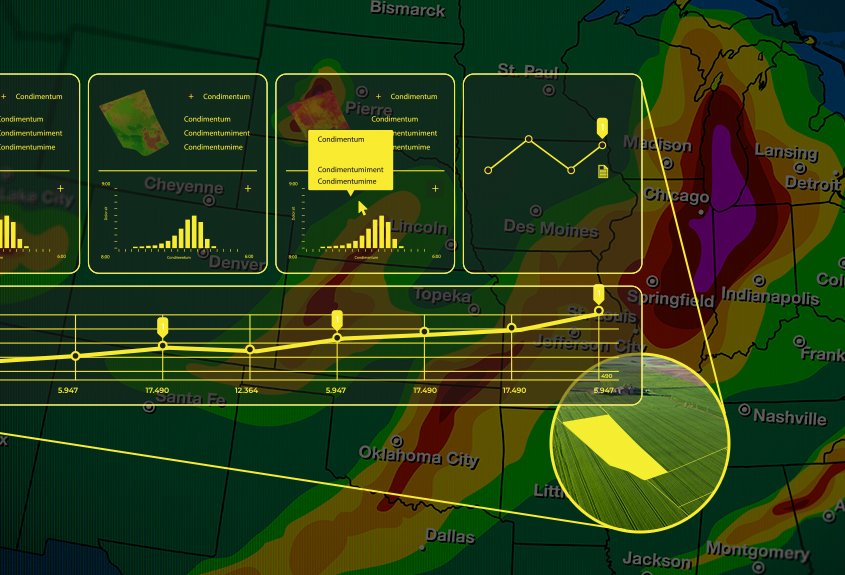Prep the Farm for Extreme Weather

- Certain agricultural practices reduce extreme weather’s impact.
- Standability may be more important than yield in certain corn geographies.
- Pruning methods reduce pecan tree loss from hurricanes.
Agriculture is vulnerable to every kind of extreme weather: hail, flood, drought, wind and more. Extreme weather causes devastating levels of damage and has long-lasting consequences, but there are proactive practices and technologies that reduce damage and help operations recover.
“When most [growers] are asked what their greatest source of risk is in agriculture, they'll tell you it’s the weather,” says Eric Snodgrass, senior science fellow at Nutrien Ag Solutions. “You can ask any farmer; they’re all going to have a story.”
Marianne Brown, a pecan grower and owner of T&M Brown Farms, LLC in Albany, Georgia has such a story. She is also a partner on TriBaum Farms and helps manage Grebel Pecan Services, Inc.; all three pecan-growing companies were affected by Hurricane Michael in 2018 and lost approximately 30% of trees in the storm.
Plan for Extremes
Planning is the best remedy. Crop insurance is a risk management necessity, but there are also practices growers can put in place to reduce the impact of extreme weather and reinforce crop durability.
For annual crops such as corn, Snodgrass recommends seed choice selectivity. He says growers should understand seed vulnerability to various factors, such as wind, before making their selection. For an area like the western corn belt, he says it might be worth sacrificing yield for stand quality. “I would want to make sure it was harvestable, given all the wind out there,” he says.
Seed selection is an important consideration in perennial crops as well. Newer varieties and techniques may offer better resistance to extreme conditions. For crops like pecans, growers carefully plan planting for the best chance at weather resistance.
When most [growers] are asked what their greatest source of risk is in agriculture, they'll tell you it’s the weather. You can ask any farmer; they’re all going to have a story.
“Most farmers are trying to update their orchards by inter-planting – replacing older trees and skips with young trees. Some farmers even put a high-density planting of young trees next to an older orchard so that when they lose a tree, a young tree can be spaded in,” Brown says. “Due to their size, younger trees are more resilient, so they’re more likely to survive and can replace older, damaged trees.”
Follow Best Practices
Certain maintenance practices improve overall crop health, yield and extreme weather resilience. For example, hedging is a practice in pecan farming in which pruning stimulates growth patterns more like hedge rows than typical trees. It allows for better spray coverage and opens the canopy to more sunlight. As it turns out, hedging also reduces hurricane damage.
“Now there’s data after [Hurricanes] Irma and Michael that hedging trees has a significant impact on them staying upright and reducing loss from a hurricane,” says Brown.
Snodgrass states the importance of soil health and stewardship for both healthy crops and weather damage reduction. “The best offense is a good defense,” he says. “Knowing your own ground and your own soil means that you’ll do what’s best for it. It’s kind of like human health: if you do all the right things, everything seems to work well.” It can be a lot to juggle at once, but farms implementing good stewardship practices are more resilient to extreme weather.
Stay Up-to-date
Part of good stewardship is understanding soil and plant health, but updating farm equipment also helps before and after a disaster. In the wake of Hurricane Michael, Brown replaced many damaged trees, resulting in considerable variability in tree height within her orchards. She purchased a smart sprayer that uses LIDAR (Light Detection and Ranging) technology to precisely spray chemicals.
“We've easily saved 40% of our chemical cost,” Brown says. “This upgrade should prove helpful should a similar disaster strike in the future.”
Weather prediction has also improved. “We’re getting much better at predicting things farther out,” says Snodgrass. “We can predict weather with relative certainty up to 10 days in advance.” The National Weather Service and other sites, such as ag-wx.com, offer weather predictions and models across the country and are an important resource for growers.
Incorporate Industry Improvements
Researchers like Snodgrass continue to look for ways to mitigate extreme weather risk in agriculture. “[Researchers] are improving soil health,” says Snodgrass. “They’re improving our sustainability metrics. They’re improving things that make us less vulnerable to severe weather events.”
Technology, such as Cropwise™ Imagery, makes monitoring plant health easier than ever. Growers can view satellite imagery of their fields, compare fields over time, and see NDVI (Normalized Difference Vegetation Index) values from anywhere.
Brown sees continued improvements in the industry as well. “Incorporating hedging and precision ag – whether that’s monitors or smart sprayers – have positively affected the industry,” she says. She knows she’s prepared should a similar disaster hit her farms again. “We’re resilient, and technology and information have come a long way. We’ve learned a lot from Irma and Michael and, ultimately, it’s going to make us better growers.”
click to tweet ![]()

